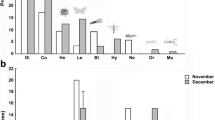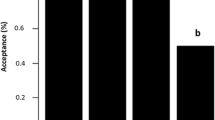Summary
-
1-
In the communal, non-territorial spiderMallos gregalis, large numbers of individuals share communal webs and feed as groups on the same prey. The seemingly cooperative nature of this behavior is critically examined.
-
2-
It is misleading to characterize the behavior of spiders when they contact prey as a cooperative predatory attack since the web, rather than the direct action of the spiders, is evidently the principal factor in subduing prey. Flies landing on webs are trapped for considerable time periods, often indefinitely, even if not contacted by spiders.
-
3-
Predation may be indirectly cooperative through web-building activites, since larger webs built by larger groups of spiders are more effective traps.
-
4-
Since adult males lack functional cribella, they seem to be at least partially parasitic with respect to web building and predation.
-
5-
Some individuals bite flies, then depart after a short period. Other spiders remain and feed on these flies. Possibly, the departing spiders contribute to the handling of prey upon which they do not themselves feed.
Resume
-
1-
Dans l'espèce d'araignée grégaire et non territorialeMallos gregalis, un grand nombre d'individus partagent des toiles communes et se nourrissent de la même proie. L'apparente nature coopérative de ce comportement est examinée sous un angle critique.
-
2-
Il est illusoire de dépeindre le comportement des araignées quand elles entrent en contact avec leur proie comme une chasse coopérative puisque l'agent principal dans la capture des proies est la toile et non pas l'action directe des araignées. Des mouches qui se font prendre dans les toiles sont retenues captives pendant une durée considérable, souvent indéfiniment, même si les araignées n'entrent pas en contact avec elles.
-
3-
La chasse est peut-être indirectement coopérative du fait du tissage des toiles car les grandes toiles filées par de grands groupes d'araignées sont des pièges plus efficaces.
-
4-
Comme les mâles adultes ont des cribella qui ne fonctionnent pas, ils semblent être parasites, du moins en partie, en ce qui concerne le tissage de la toile et la chasse.
-
5-
Tandis que des individus mordent les mouches puis les abandonnent après une période, d'autres araignées restent là et mangent ces mouches. Il est possible que les araignées qui ne restent pas près des mouches contribuent au traitement de la proie dont elles ne se nourrissent pas elles-mêmes.
Similar content being viewed by others
References
Barrows W.M., 1915. — The reactions of an orb-weaving spider,Epeira scoloptearia Clerck, to rhythmic vibrations of its web.Biol. Bull., 29, 316–332.
Beer C.G., 1977. — What is a display?Am. Zool., 17, 155–165.
Burgess J.W., 1975. — The sheet web as a transducer, modifying vibration signals in social spider colonies ofMallos gregalis. Neurosciences (Abstracts), New York.
Burgess J.W., 1976. — Social spiders.Sci. Am., 234, 101–106.
Burgess J.W. andWitt P.N., 1976. — Spider webs: design and engineering.Interdispl. Sci. Rev., 1, 322–335.
Chauvin R., 1968. — Animal Societies from the Bee to the Gorilla (English trans. by G. Ordish).Hill and Wang, edit., New York, 281 p.
Curio E., 1976. — The Ethology of Predation.Springer-Verlag, edit., Berlin, Heidelberg and New York, 250 p.
Darchen R., 1965. — Ethologie d'une araignée socialeAgelena consociata Denis.Biologia Gabonica, 1, 117–146.
Darchen R., 1967. — Ethologie de quelques araignées sociales. L'interattraction, la construction et la chasse.5eCongrès U.I.E.I.S., Toulouse, 1967, 333–345.
Diguet L., 1909a. — Sur l'araignée mosquero.C.R. Acad. Sci., 148, 735–736.
Diguet L., 1909b. — Le mosquero.Bull. Soc. Acclim. France, 56, 368–375.
Diguet L., 1915. — Nouvelles observations sur le mosquero ou nid d'araignées sociales employé comme piège à mouches dans certaines localités du Mexique.Bull. Soc. Acclim. France, 62, 240–249.
Foelix R.F., 1970. — Structure and function of tarsal sensilla in the spiderAraneus diadematus.J. Exper. Zool., 175, 99–124.
Gardner B.T., 1964. — Hunger and sequential responses in the hunting behavior of salticid spiders.J. Comp. Physiol. Psychol., 58, 167–173.
Gertsch W.J., 1949. — American Spiders.Van Nostrand, edit., Princeton, New Jersey, 285 p.
Jackson R.R., 1977. — Comparative studies ofDictyna andMallos (Araneae: Dictynidae): I. Social organization and web characteristics.Rev. Arachnol., 1, 133–164.
Jackson R.R., 1978. — Comparative studies ofDictyna andMallos (Araneae: Dictynidae): II. The relationship between courtship, mating, aggression, and cannibalism in species with differing types of social organization.Rev. Arachnol., 2, 103–132.
Jackson R.R., 1979. — Comparative studies ofDictyna andMallos (Araneae: Dictynidae): III. Prey and behavior.Psyche, 83, 267–280.
Jackson R.R., Smith S.E., 1978. — Aggregations ofMallos and Dictyna (Araneae: Dictynidae): population characteristics.
Krafft B., 1970. — Contribution à la biologie et à l'éthologie d'Agelena consociata Denis (Araignée sociale du Gabon). Première partie.Biologia Gabonica, 6, 197–301.
Krafft B., 1971. — Contribution à la biologie et à l'éthologie d'Agelena consociata Denis (Araignée sociale du Gabon). Troisième partie. Etude expérimentale de certains phénomènes sociaux.Biologia Gabonica, 7, 3–56.
Kruuk H., 1972. — Surplus killing by carnivores.J. Zool. Lond., 166, 233–244.
Kullmann E., 1970/71. — Bemerkenswerte Konvergenzen im Verhalten cribellater und ecribellater Spinnen.Freunde Kölner Zoo, 13, 123–150.
Kullmann E., 1972. — Evolution of social behavior in spiders (Araneae; Eresidae and Theridiidae).Am. Zool., 12, 419–426.
Peters H.M., 1931. — Die Fanghandlung der Kreuzspinne (Epeira diademata L.). Experimentelle Analysen des Verhaltens.Z. Vergl. Physiol., 15, 693–748.
Sandness J.N., McMurty J.A., 1972. — Prey consumption ofAmblyseius largeonsis in relation to hunger.Canad. Entomol., 104, 461–470.
Sokal R.R., Rohlf F.J., 1969. — Biometry.Freeman, edit., San Francisco, 776 p.
Sudd J., 1963. — How insects work in groups.Discovery, 15–19.
Wilson E.O., 1975. —Sociobiology.Belknap Press, edit., Cambridge, Mass. 697 p.
Witt P.N., 1975. — The web as a means of communication.Biosc. Comm., 1, 7–23.
Witt P.N., Reed C.F., Peakall D.B., 1968. — A Spider's Web.Springer Verlag, edit., Berlin, Heidelberg and New York, 107 p.
Witt P.N., Scarboro M.B., Peakall D.B., 1978. — Comparative feeding data in three spider species of different sociality:Araneus diadematus Cl.,Mallos trivittatus (Banks) andMallos gregalis (Simon).Symp. Zool. Soc. Lond., 42, 89–97.
Author information
Authors and Affiliations
Rights and permissions
About this article
Cite this article
Jackson, R.R. Predatory behavior of the social spiderMallos gregalis: Is it cooperative?. Ins. Soc 26, 300–312 (1979). https://doi.org/10.1007/BF02223550
Received:
Accepted:
Published:
Issue Date:
DOI: https://doi.org/10.1007/BF02223550




